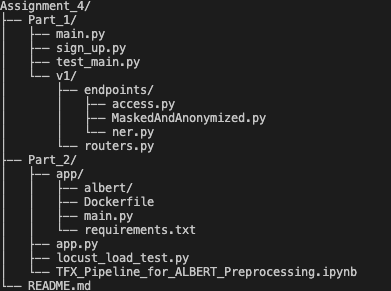CSYE7245 - Assignment_4: Named-Entity-Recognition Serverless Pipeline and Sentiment Analysis-as-a-service
Quick Links
Getting Started
This project has two parts.
Part 1: Goal of the first part of the project is to create API that Anonymizes the data through:
- Masking
- Anonymization
Then, building upon the Infrastructure for login and server less functions using Cognito and integrating the APIs so that only authenticated users can call these APIs.
Part 2: In this part of the project, we are building upon the pre-processed (anonymized/masked data) and build a sentiment analysis model that could take the location of the anonymized file as an input and generate sentiments for each sentence.
We are using the IMDB datasets as a proxy and building a sentiment analyzer.
Task performed
- Task 1: Three APIs Creation
- Task 2: Model as a service for anonymized data
- Step 1: TensorFlow Model
- Step 2: FastAPI to serve the model
- Step 3: Dockerize the API service
- Step 4: Streamlit to test the API
- Step 5: Unit Testing and Load Testing for API
Project Structure
Task 1: Three APIs
- We have created authorized apis which could be used by our users who have signed up and can get access and id tokens generated using Amazon Cognito which we are stored in dynamo db
API 1: Access
This API should retrieve the EDGAR filings data from the S3 bucket
API 2: Named entity recognition
This API should take a link to a file on S3 and
- Call Amazon Comprehend to find entities.
- Store these on S3
API 3: Implement masking, and anonymization functions.
We define the API in a way that indicate which entities need to be masked, which needs to be anonymized. We are getting the location of the file/files as input and output the files back to S3.
Task 2: Model as a service for anonymized data
To deploy a sentiment analysis model or to create a Model-as-a-service for anonymized data
Step 1:Train TensorFlow models using TensorFlow Extended(TFX)
Replicated the architecture to train the model for the anonymized data using ALBERT and this architecture that leveragesTensorFlow Hub,TensorflowTransform,TensorFlow Data Validation and Tensorflow Text and Tensorflow Serving.
The pipeline takes advantage of the broad TensorFlowEcosystem, including:
- Loading the IMDB dataset via TensorFlow Datasets
- Loading a pre-trained model via tf.hub
- Manipulating the raw input data with tf.text
- Building a simple model architecture with Keras
- Composing the model pipeline with TensorFlow Extended,e.g. TensorFlowTransform, TensorFlow Data Validation and then consumingthe tf.Kerasmodel with the latest Trainer component from TFX
Step 2: FastAPI to serve the model
setup:
Install FastAPI framework, high performance, easy to learn, fast to code, ready for production
pip install fastapi
Install the lightning-fast ASGI server Uvicorn
pip install uvicorn
API: We have a POST method where we give the URL of the S3 file and get the predicts using Albert model
Step 3: Dockerize the API service
Prerequisites
Your development and production environments are constructed by Docker. Install Docker for Desktop for your OS.
To verify that Docker is installed, run docker --version.
Simple Case: One Container
In this directory, we have Dockerfile, a blueprint for our development environment, and requirements.txt that lists the python dependencies.
We made use of the following command to create our docker image:
# Tensforlow 2 official image with Python 3.6 as base
FROM tensorflow/tensorflow:2.0.0-py3
# Make working directories
RUN mkdir -p /home/project-api
WORKDIR /home/project-api/
# Upgrade pip with no cache
RUN pip install --no-cache-dir -U pip
# Copy application requirements file to the created working directory
COPY requirements.txt .
# Install application dependencies from the requirements file
RUN pip install -r requirements.txt
# Copy every file in the source folder to the created working directory
COPY . .
# Run the python application
CMD ["python", "main.py"]
Build:
Local
To serve the provided pre-trained model, follow these steps:
git clonethis repocd Assignment_4/app/docker build -t nidhi2019/edgar-sentiment-analyzer-api:latest .
Dockerhub
docker pull nidhi2019/edgar-sentiment-analyzer-api
Run
docker run -it --rm -p 8000:8000 nidhi2019/edgar-sentiment-analyzer-api
If everything worked properly, you should now have a container running at server http://0.0.0.0:8000/
Step 4: Streamlit App
Setup:
pip install fastapi
To run the application, run
streamlit run app.py
Application:
If we give the s3 link of the anonymised file, we should be able to see the prediction score of the transcript
Step 5: Test API
Test Unit Cases
Setup:
Install PyTest by running this:
% pip install pytest
Using TestClient
Import TestClient
Create a TestClient passing to it your FastAPI.
Create functions with a name that starts with test. (this is standard pytest conventions).
Use the TestClient object the same way as you do with requests.
Write simple assert statements with the standard Python expressions that you need to check (again, standard pytest).
Run the command to test all use cases in test_main.py,
pytest or pytest -v
Locust Load Test
Setup:
1.Install the libraries
pip install locustio==0.14.6
pip install greenlet==0.4.16
Processs
-
Make a .py file similar to locust_load_test.py to test the load test
-
To run the file
locust -f query_locust.py
- Open the browser and enter the following url
http://localhost:8089/
- Fill up the Number of users to simulate, Hatch rate, Host and click Start swarming
Team Members:
- Nidhi Goyal
- Kanika Damodarsingh Negi
- Rishvita Reddy Bhumireddy
Citation:
- https://aws.amazon.com/blogs/machine-learning/identifying-and-working-with-sensitive-healthcare-data-with-amazon-comprehend-medical/
- https://aws.amazon.com/blogs/machine-learning/detecting-and-redacting-pii-using-amazon-comprehend/
- https://docs.aws.amazon.com/apigateway/latest/developerguide/integrating-api-with-aws-services-s3.html
- https://testdriven.io/blog/fastapi-streamlit/
- https://github.com/google-research/albert
- https://github.com/google-research/ALBERT/blob/master/run_classifier.py



